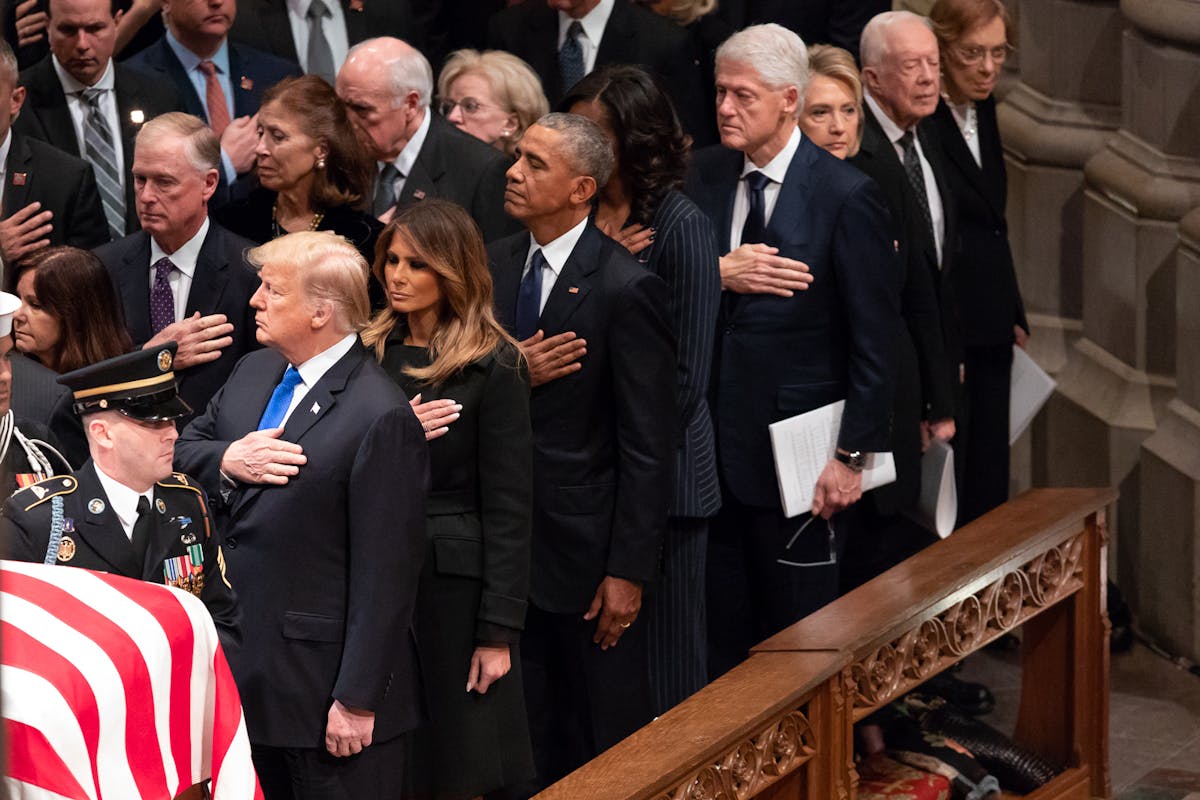‘Mourning the Presidents’ Considers How the Republic Eulogizes its Leaders
Historians look back at the pomp and pageantry accompanying the death of presidents, from simple ceremonies to state funerals, to bring greater insight into the American experiment.

‘Mourning the Presidents: Loss and Legacy in American Culture’
By Lindsay Chervinsky, Matthew Costello, et al.
University of Virginia Press, 332 pages
“Grief,” President John Adams wrote to President Jefferson, “drives men into habits of serious reflection, sharpens the understanding and softens the heart.” Guided by this wisdom, scholars examine how different generations and communities have chosen to process grief in “Mourning the Presidents: Loss and Legacy in American Culture.”
President Washington — eulogized as “First in war, first in peace, and first in the hearts of his countrymen,” by General Henry “Light Horse Harry” Lee — was the first chief executive to pass away, and the first to have his wishes ignored.
“Washington,” one of the book’s authors, Lindsay Chervinsky, told me in our “History Author Show” interview, “laid out sort of a very detailed but very simple plan. He just wanted a family service at his home.” However, Ms. Chervinsky added that “Everyone just said, ‘No. He belongs to the American people.’”
As tributes to President Washington dragged on, the first lady, Abigail Adams, wondered if there had ever been three months of celebration for anyone in history. She felt exaggeration, we come to understand in “Mourning the Presidents,” was a disservice because the Father of His Country’s record required no gilding.
President Jefferson wanted no mention of his presidency and no monument, requesting that his epitaph read only that he was founder of the University of Virginia, the Declaration of Independence’s primary author, and had written Virginia’s statute guaranteeing religious freedom.
“It’s always tricky to say the founders would think anything because they disagreed on almost everything,” Ms. Chervinsky said. Some, like Alexander Hamilton, might have welcomed “the pageantry and the flair and the pomp and circumstance.”
Others, Ms. Chervinsky said, “would be extremely uncomfortable where we have traveled to as a nation, because the ceremonies that we now have regularly for former presidents are not all that dissimilar from the ceremonies that occur when a monarch dies in England.”
The chapter written by a doctoral fellow at Southern Methodist University, Camille Davis, is titled, “The Mixed Legacy of Zachary Taylor: Mourning a Soldier, Losing a President” and offers a sharp contrast to those early funereal pageants.
President Taylor;s leadership was unremarkable as the secession crisis loomed, so when he passed away in office, the nation focused on honoring his service in the war with Mexico, as they had for President William Henry Harrison’s War of 1812 heroics when he died after just a month at the White House.
“Mourning the Presidents” explains that while today, presidents are expected to have a detailed plan for their funeral on file, in the past, many didn’t. Among the unprepared was President Franklin Delano Roosevelt, who was dying as he began his unprecedented fourth term in 1944. He would not complete it.
As described by a professor at Marist, David Woolner, FDR was, upon his death, the only president many Americans had ever known, having led the nation through twelve years of economic and military challenges.
One passage in “Mourning the Presidents,” penned by a professor at Ohio State, Dean Kotlowski, focuses on the man FDR defeated.“Farewell to the Chief: Mourning and Memorializing Herbert Hoover” examines how — after a 30 year post-presidency — Hoover found redemption for the Great Depression in death.
Presidents Lincoln, Garfield, McKinley, and Kennedy were all slain by assassins, which prompted various species of remembrances, often improvised and raw. President Van Buren, who died as the Civil War raged twenty years after he left office, was little noticed. Worse was the fate of President Tyler, who had been elected to the Confederate Congress. He was shunned.
Although burials with dispatch for presidents may seem surprising today, when we’ve become accustomed to state funerals and presidential deaths are relatively rare, in earlier centuries a minimalist funeral was standard, unless you were of the caliber of a President Lincoln or Grant.
The funeral of President George H. W. Bush in 2018 helped inspire “Mourning the Presidents,” with Mr. Bush — the last commander-in-chief to serve in World War II — evoking the national unity that Americans tell pollsters they crave while the partisan divide grows ever larger.
“Mourning the Presidents” recounts how our republic has eulogized its chief executives, but it’s not a book preoccupied with sadness. It’s a roadmap for the living to soften our hearts and learn from the legacies of those who labored, with varying degrees of success, to create a more perfect union.

